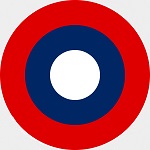Wings of the Great War WW15101 French Spad S.A.4 Biplane Fighter with Skis (1:72 Scale)
"Courage is doing what you are afraid to do. There can be no courage unless you are scared."
- Eddie Rickenbacker
 The SPAD S.XIII was a French biplane fighter aircraft of World War I, developed by Socit Pour L'Aviation et ses Drivs (SPAD) from the earlier highly successful SPAD S.VII. It was one of the most capable fighters of the war, and one of the most-produced, with 8,472 built and orders for around 10,000 more cancelled at the Armistice.
The SPAD S.XIII was a French biplane fighter aircraft of World War I, developed by Socit Pour L'Aviation et ses Drivs (SPAD) from the earlier highly successful SPAD S.VII. It was one of the most capable fighters of the war, and one of the most-produced, with 8,472 built and orders for around 10,000 more cancelled at the Armistice.
The SPAD XIII was standardized by the Aronautique Militaire as the equipment of its own escadrilles de chasse (fighter squadrons) for 1918. The SPAD was also the first choice of the United States Air Service - however a shortage of SPADs led to the available production Nieuport 28s equipping four American squadrons between March and August 1918. It thus became the first aircraft to see operational service with an American fighter squadron.
The SPAD S.VII was a single-seat fighter aircraft powered by a 150 horsepower (110 kW) Hispano-Suiza 8A water cooled V-8 engine and armed with a single synchronised Vickers machine gun. It demonstrated excellent performance for the time, and entered service with the French Aronautique Militaire in August 1916. By early 1917, however it had been surpassed by the latest German fighters, leading French flying ace Georges Guynemer to lobby for an improved version telling the SPAD designer Louis Bchereau that "The 150 hp SPAD is not a match for the Halberstadt ... More speed is needed." An initial solution was to increase the compression ratio of the Hispano-Suiza engine, increasing its power to 180 hp (130 kW), which gave significantly improved performance, allowing the SPAD S.VII to remain competitive, but Hispano-Suiza were developing a geared version of the 8A engine, which would produce greater power, and this engine was chosen by Bchereau for two new fighter aircraft. First to fly was the S.XII, armed with a 37 mm cannon firing through the propeller shaft. This saw limited use, but was followed into production by the more conventionally armed S.XIII.
Pictured here is a 1:72 scale replica of a french-built SPAD S.A.4 biplane fighter with skis.
Pre-order! Ship Date: July 2024.
Dimensions:
Length: 4-inches
Wingspan: 5-inches
Release Date: ?
Historical Account: "Home Before the Snow Flies" - The SPAD S.A had a short and inauspicious career in the French Aviation Militaire, and it was quickly replaced in service by less dangerous aircraft. Contemporary sources indicate that it was seldom used. Few details are available concerning the careers of the 42 S.A-2 air frames delivered, and it never supplied the entire equipment of an escadrille.
The Imperial Russian Air Service operated the SPAD S.A-2 and S.A-4 for a longer period of time due to a shortage of available aircraft. Some 57 S.A-2s and S.A-4s went to the Imperial Russian Air Service. During winter operations, Russian aircraft were fitted with skis instead of wheels. Although Russian crews also thought very little of the SPAD (not made any better by the acronym SPAD (СПАД) in Russian meaning "slump" or "plummet"), at least two crews achieved successes with it.


